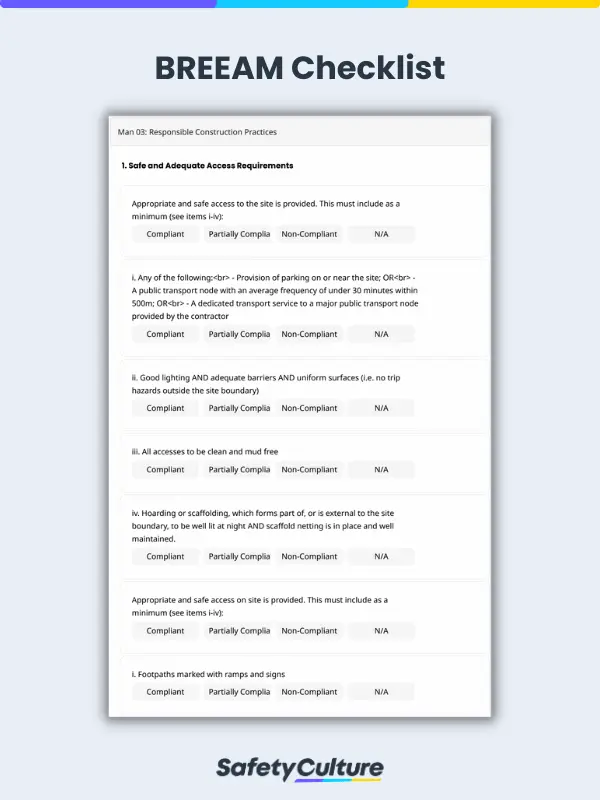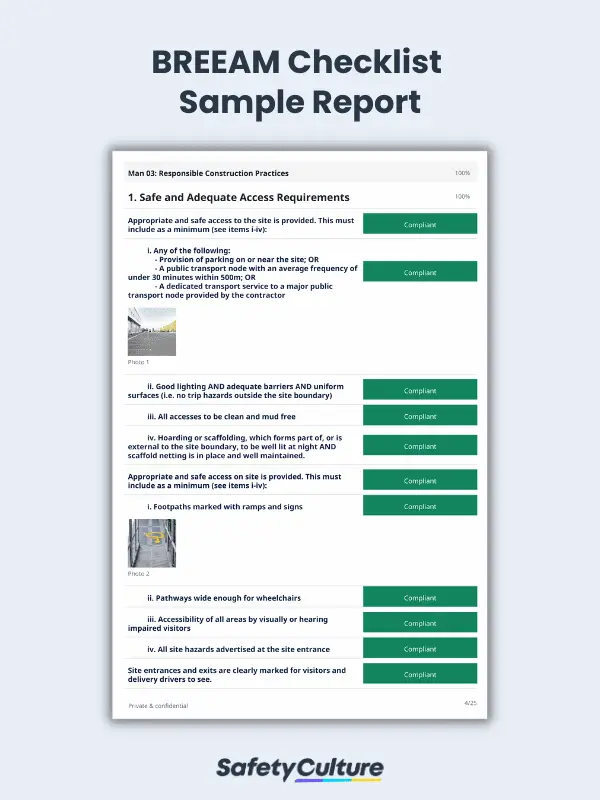What is a BREEAM Checklist?
A BREEAM checklist outlines the criteria for assessing structures against the Building Research Establishment Environmental Assessment Methodology (BREEAM) standard. It covers vital sustainability categories to evaluate the environmental performance of newly built, refurbished, and in-use buildings based on the requirements of this international standard. Businesses can refer to this checklist during internal audits to check for compliant and non-compliant aspects in their structure.
Why Use One?
Preparing for green building assessments such as BREEAM needs time and careful planning. After all, these standards have an array of requirements that must be satisfied in order to get certified. And aside from the site requirements, documentation is also a must for compliance.
Having a checklist at hand is incredibly helpful for simplifying this process. This tool takes the guesswork out of inspections by mapping out the benchmarks against which the building will be evaluated. During self-audits, assessors can refer to their checklist when looking for compliant and non-compliant areas in their structure.
Not only does it save time and resources, but it also minimizes the likelihood of mistakes and overlooked items during internal assessments. This way, companies can identify opportunities for enhanced compliance and proactively respond to issues within the process.
What to Include in a BREEAM Checklist
A checklist is an essential tool when performing internal BREEAM assessments in preparation for the actual one. Its structure and content will depend on the type of building and certification you’re going for. In the case of newly constructed buildings, here are the items your BREEAM checklist should have:
- Responsible Construction Practices – This section focuses on the management aspect of the construction site, specifically the environmental and social impacts of construction processes from noise hazards to site waste management.
- Visual Comfort – This section revolves around the visual aspect of the building design and covers metrics such as lighting (both natural and artificial) and occupant controls.
- Indoor Air Quality – As one of the key indicators of a healthy indoor environment, this section looks closely into the ventilation systems for maintaining good indoor air quality.
- Water Quality – This section checks the quality of water sources in the structure to reduce the risk of contamination.
- Reduction of Energy Use and Carbon Emissions – This section outlines the required components to be integrated into the building design for less energy consumption and carbon footprint.
- Water Consumption – This section examines the water systems for sanitary use in the locality of the new building.
- Water Monitoring – This section specifies guidelines for monitoring water consumption patterns to determine opportunities for water-saving solutions.
- Responsible Sourcing of Construction Products – Lastly, this section provides a framework for procuring construction materials in a sustainable manner.
Common Mistakes to Avoid During BREEAM Assessments
Once you have a BREEAM checklist, the next step is to implement it in your internal checks. But even with this tool on hand, it’s still possible to commit errors along the way. Here are some of the most common mistakes to watch out for during assessments:
- Failing to provide sufficient evidence – BREEAM assessments require a significant amount of supporting documents as proof of compliance with the standard. Thus, it’s important to prepare all necessary evidence materials, such as photographs, technical reports, and calculations, before the process begins.
- Focusing too much on one category – When implementing BREEAM standards in practice, it’s easy to get fixated on meeting the requirements of one category at the expense of others. For this reason, it’s essential to strike a balance between targeting specific areas, especially non-compliant ones, and continuously monitoring the rest.
- Failing to consider long-term benefits and costs – Setting goals and establishing BREEAM-compliant measures should account for both short-term and long-term impacts. For example, aside from the initial expenses of sustainability initiatives, such as renewable energy and commissioning, it’s also important to factor in their potential costs and benefits in the long run.
FAQs about BREEAM Checklists
BREEAM standards have four categories of buildings and spaces, as follows:
- New construction – assesses the design and construction of newly built structures
- Refurbishment and fit-out – measures the environmental impacts of renovation works
- In-use – evaluates the performance of existing buildings and operational assets
- Communities – integrates sustainable design into community planning and restoration projects
While both establish sustainability benchmarks for building performance, BREEAM and LEED differ in their scope and assessment methods.
For one, BREEAM is a widely-used green building standard across Europe (including Spain, Norway, Sweden, and the United Kingdom) that employs third-party assessors to assess and certify structures. On the other hand, the US-based Leadership in Energy and Environmental Design (LEED) standard evaluates buildings worldwide based on the data submitted to the US Green Building Council (USGBC).
The duration of BREEAM assessments can vary depending on the size and complexity of the building, as well as the type of certification you’ve applied for. On average, the time it takes to complete these assessments can range from a few weeks to several months, especially for structures that require frequent site inspections.




